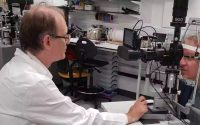Oxytocin and Social interaction Improves Symptoms in Autism
The study covered in this summary was published on medRxiv.org as a preprint and has not yet been peer reviewed.
Key Takeaways
-
Novel reduced-dose intranasal oxytocin followed by a period of positive social interaction improved symptoms in young children with autism spectrum disorder (ASD).
-
In the study, improvement was seen in objective and subjective measures, and there was first evidence of improved social functioning using two eye tracking–derived measures.
Why This Matters
-
There is no frontline therapy to address social symptoms of ASD.
-
Long-term use of intranasal oxytocin is associated with a reduced response to emotional stimuli.
-
This is the first placebo-controlled study to demonstrate changes in the the Autism Diagnostic Observation Schedule–2 (ADOS-2) score with intranasal oxytocin.
Study Design
-
The study was a pilot double-blind, randomized, crossover trial with 41 children with ASD aged 3 – 8 years.
-
Participants with genetic disease, chromosomal abnormalities, neurologic disease, psychiatric disorder, or severe respiratory, hearing, or vision impairment were excluded.
-
-
Study participants received intranasal placebo over a 2-week period, after which they were randomly assigned in a 1:1 ratio to receive a 6-week treatment of either intranasal oxytocin or intranasal placebo every other morning followed by a 30-minute positive social interaction session.
-
Primary outcomes were the ADOS-2 score and total score on the Social Responsiveness Scale, Second Edition (SRS-2).
-
Secondary measures included a general assessment of adaptive behavior (Adaptive Behavior Assessment Schedule), social communication (Social Communication Quotient), and repetitive behaviors (Repetitive Behavior Scale–Revised).
-
Caregivers completed questionnaire-based measures at a 6-month follow-up to assess the long-term impact of the intervention.
-
Intranasal oxytocin was associated with significant improvements in primary outcome measures (P < .001) as well as behavioral adaptability and repetitive behavior secondary measures compared to placebo.
-
An increase in time spent viewing dynamic social stimuli was observed in the treatment group.
-
On the 6-month follow-up questionnaire, the SRS-2 score remained significantly improved in the intranasal oxytocin group compared to the patients who received placebo.
-
No adverse side effects were reported.
-
Crossover designs do not reliably assess duration of effects.
-
Longer treatment durations may have resulted in improved social and repetitive behavior symptoms.
-
The required period of positive social interaction following intranasal treatments was not controlled or structured.
-
The study was supported by grants from the Key Technological Projects of Guangdong Province Development of New Tools for Diagnosis and Treatment of Autism and the UESTC High-End Expert Project Development.
-
The authors have disclosed no relevant financial relationships.
Key Results
Limitations
Disclosures
This is a summary of a preprint research study, “Infrequent Intranasal Oxytocin Followed by Positive Social Interaction Improves Symptoms in Autistic Children: A Pilot Randomized Clinical Trial,” by Jiao Le from the Clinical Hospital of Chengdu Brain Science Institute in China and colleagues, published on medRxiv.org, and provided to you by Medscape. The study has not yet been peer reviewed. The full text of the study can be found on medRxiv.org.
For more news, follow Medscape on Facebook, Twitter, Instagram, and YouTube.
Source: Read Full Article


